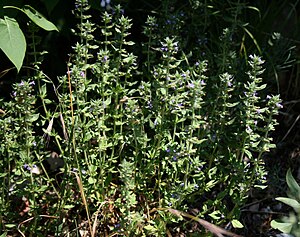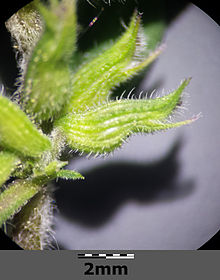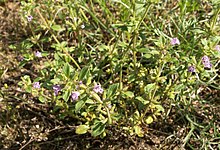Field Stone Quendel
| Field Stone Quendel | ||||||||||||
|---|---|---|---|---|---|---|---|---|---|---|---|---|

Field stone quendel ( Acinos arvensis ) |
||||||||||||
| Systematics | ||||||||||||
|
||||||||||||
| Scientific name | ||||||||||||
| Acinos arvensis | ||||||||||||
| ( Lam. ) Dandy |
The acinos arvensis ( Acinos arvensis ), also Common Steinquendel called, is a plant from the genus Steinquendel ( Acinos ) within the family of Labiatae (Lamiaceae).
Description and phenology
Vegetative characteristics
The Feld-Steinquendel is an annual to perennial herbaceous plant that reaches heights of 10 to 30 centimeters. The plant parts smell pleasantly aromatic of mint . It has prostrate to ascending stems .
The relatively small, cross-opposed leaves are divided into a short petiole and leaf blade. The simple leaf blade is about 1 centimeter long, lanceolate, oval to elliptical, with entire margins and mostly serrated in front.
Generative characteristics
Two to six short-stalked flowers are grouped together in a pseudo-whorl in the upper leaf axils.
The hermaphrodite flowers are zygomorphic and five-fold with a double flower envelope . The weakly two-lipped calyx is significantly shorter than the crown. The blue -purple crown is 7 to 15 millimeters long, red-purple with white spots on the three-lobed lower lip.
Phenology
The flowering period extends from June to September. The fruits ripen from July to the end of September.
Chromosome number
The number of chromosomes is 2n = 18.
ecology
The Feld-Steinquendel is a therophyte or a hemicryptophyte . A vegetative reproduction occurs through runners above ground .
The pollination is performed by honey bees , Hummelschweber and butterflies .
The fruit cup (with the fruit = diaspore) is closed and falls off; when dry it has an air bubble inside and is difficult to wet. The diaspore spreads as rain swarms or by ants .
Occurrence
The original distribution area of the Feld-Steinquendel includes Europe , western Siberia , Asia Minor and the Caucasus region and Iran. For example, the field stone quendula is a neophyte in northwest Africa and North America . In Europe it was originally widespread in the Mediterranean area, but has now become naturalized northwards to Scandinavia.
In Central Europe it is rare in the lowlands east of the Elbe ; in the low mountain ranges with calcareous or basic rock it occurs in a scattered manner, as well as in the warm valleys of the Alps ; it rises to the foliage tree line .
The Feld-Steinquendel grows on grasslands , on roadsides and on rubble . It settles on gaps in dry grass , walls and gaps in paths, but it also walks on rocks, dunes and dams. The Feld-Steinquendel thrives best on calcareous , low-humus , loose and often sandy-gritty soils in warm summer locations . In Central Europe it is a character species of the Sedo-Scleranthetea class, but also occurs in defective plant communities of the Festuco-Brometea class.
Taxonomy
It was first published in 1753 under the name ( Basionym ) Thymus acinos by Carl von Linné in Species Plantarum , 2, page 591. The new combination to Acinos arvensis was made in 1946 by the English botanist James Edgar Dandy in Journal of Ecology. Published London , Volume 33, p. 326. Other synonyms for Acinos arvensis (Lam.) Dandy are: Acinos thymoides Moench , Calamintha acinos (L.) Clairville ex Gaud. , Clinopodium acinos (L.) Kuntze Satureja acinos (L.) Scheele . The specific epithet arvensis means "growing in fields."
swell
Individual evidence
- ↑ a b Acinos arvensis (Lam.) Dandy, Gewöhnlicher Steinquendel. In: FloraWeb.de.
- ↑ a b Erich Oberdorfer : Plant-sociological excursion flora for Germany and neighboring areas . With the collaboration of Angelika Schwabe and Theo Müller. 8th, heavily revised and expanded edition. Eugen Ulmer, Stuttgart (Hohenheim) 2001, ISBN 3-8001-3131-5 , pp. 812 .
- ↑ a b c Ruprecht Düll , Herfried Kutzelnigg : Pocket dictionary of plants in Germany and neighboring countries. The most common Central European species in portrait . 7th, corrected and enlarged edition. Quelle & Meyer, Wiebelsheim 2011, ISBN 978-3-494-01424-1 .
- ↑ Rafaël Govaerts (Ed.): Clinopodium acinos. In: World Checklist of Selected Plant Families (WCSP) - The Board of Trustees of the Royal Botanic Gardens, Kew . Retrieved February 27, 2018.
- ↑ a b c d Dietmar Aichele, Heinz-Werner Schwegler: The flowering plants of Central Europe . 2nd Edition. tape 4 : Nightshade plants to daisy plants . Franckh-Kosmos, Stuttgart 2000, ISBN 3-440-08048-X .
- ↑ a b c d A. Kleinsteuber, T. von Breunig: Lamiaceae, Labiatae, Mint Family, Mint Family. In: Oskar Sebald, Siegmund Seybold, Georg Philippi, Arno Wörz (eds.): The fern and flowering plants of Baden-Württemberg . tape 5 : Special part (Spermatophyta, subclass Asteridae): Buddlejaceae to Caprifoliaceae . Eugen Ulmer, Stuttgart (Hohenheim) 1996, ISBN 3-8001-3342-3 .
- ^ Acinos arvensis in the Germplasm Resources Information Network (GRIN), USDA , ARS , National Genetic Resources Program. National Germplasm Resources Laboratory, Beltsville, Maryland.
literature
- A. Minkevičius et al .: Lietuvos TSR flora 3. Vilnius 1976.
Web links
- Acinos arvensis at Plants For A Future
- Field Stone Quendel . In: BiolFlor, the database of biological-ecological characteristics of the flora of Germany.
- Acinos arvensis (Lam.) Dandy In: Info Flora , the national data and information center for Swiss flora . Retrieved February 24, 2016.
- Distribution in the northern hemisphere
- Thomas Meyer: Steinquendel data sheet with identification key and photos at Flora-de: Flora von Deutschland (old name of the website: Flowers in Swabia ).
- Günther Blaich: data sheet with photos.



